Review of the ARF Cessna400 from HobbyKing.com by FMSModels.com
by Published on 05-11-2010 15:36:23
Reviewed by Rene Wallage, Netanya, ISRAEL
Introduction:
When I was asked to review the Cessna400 I grabbed the chance for two reasons.
First, when you mention the name "Cessna" the first thing that comes to mind are the boxy, sturdy, highwing, workhorse and trainer. But the Cessna400 is a sleek looking, modern, low wing sport plane. Standing still she looks fast!
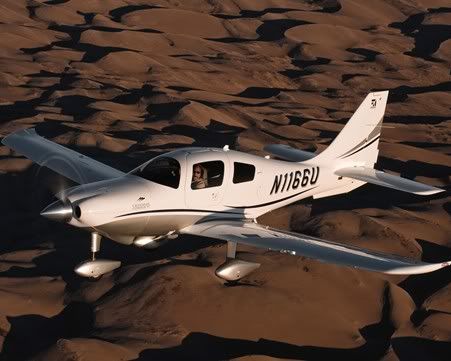
The real thing.
Secondly, the model from FMS is just the right size for an off-scale to look the part, made out of EPO foam. The 1.4mtr wingspan of the two piece wing makes her big enough to hold her own at the flight line, and be transportable in any size car.
Link to Hobby King: http://www.hobbycity.com/hobbyking/s...dProduct=11247
First impressions
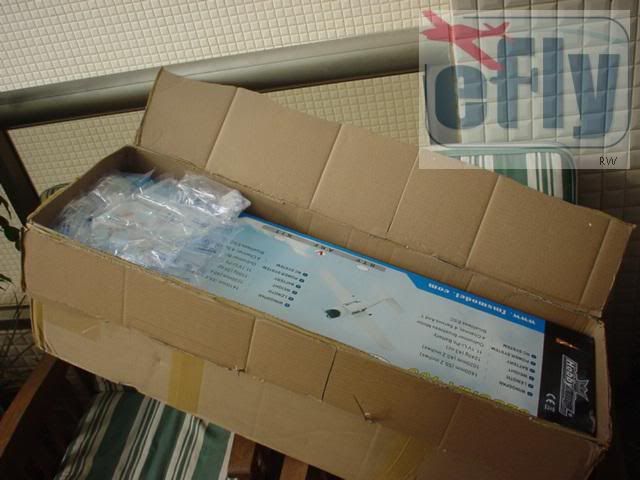
Double boxed
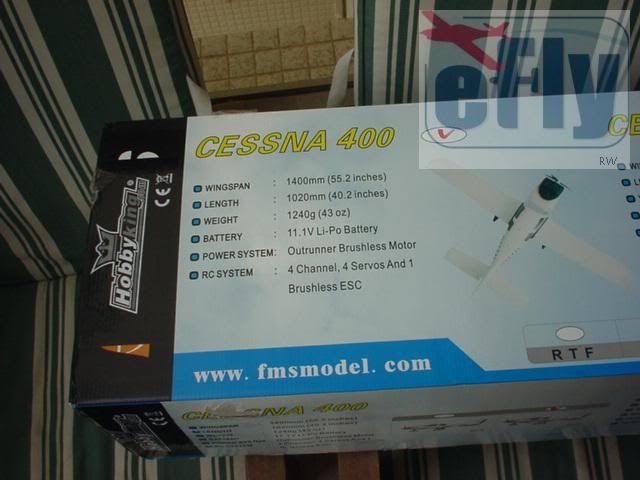
Box detail
The model arrived double boxed. And big boxes they were! Opening the boxes revealed a foam inner box with every part in its' own plastic bag, taped down for secure transportation.

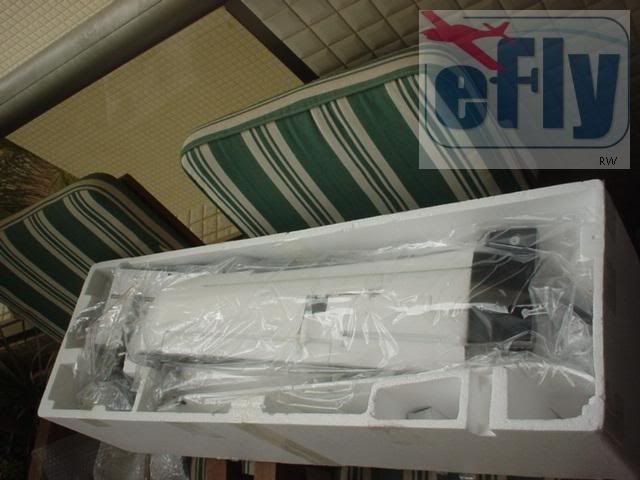
GREAT, apart from one thing: how come the rudder was broken off on the hingeline? The way the model was packed, I have the distinct impression this could only have happened before or during packing and not in transit. That was a bit of a bummer.

A further stocktake showed an extremely complete ARF. All servos (4 of them), pushrods, and clevises are factory installed, as are the motor and ESC, and all stickers and decals. The sturdy looking main landing gear and nose wheel are pre-assembled, including wheel pants. Ailerons and elevator have live hinges. The rudder, if it wouldn't have broken of, also has live hinges, which made the repair on my model very easy. The break was right on the hinge line, so I just cleaned it up and inserted three CA hinges. All of 5 minutes work.
In addition, I found a nice three-bladed 11x7 prop, a grey plastic spinner, two carbonfiber rods for the wing, a fiberglass flatrod for the elevator and contact glue.
And if that's not enough, there are also additional pushrods, clevises and control horns if you want to add flaps.
The pushrods are installed and connected to their relevant servos. The two elevator halves each have their own pushrod, that are inserted into a EZ-connector.

Elevator servo
The rudder servo also controls the nose wheel, and here as well the pushrods for both controls are inserted in a EZ-connector. Crude, but works just fine.

Rudder servo
To round it of, there is also an A3 size sheet of instructions and other information.
Assembly
The "work" needed to get the 400 ready for flight (apart from the rudder repair) contains:
- Attach control horns to the elevator halves.
- Glue the fiberglass flatrod in one elevator half, insert and glue it into the vertical stab. Repeat with the other elevator half on the other side.
- Insert your receiver in the cavity over the wing, hookup the servos, and center the servos.
- Attach the pushrods to the rudder, elevator, and ailerons' control horns.
- Insert two carbonrods into the wing and assemble the two winghalves.
- Insert the nosewheel in the nose.
- Insert the main gear in its receptacle.
- Attach cowl.
- Attach spinner backplate, prop, and spinner.
- Program the Tx
- GO FLY
And now the reality.
In principle it all looks very good, but I encountered several problems and downsides.
Instructions:
Let's start with the instructions, and I use that word carefully. The instruction sheet is the main reason I suspect this model is aimed towards someone who has a few ARF's under his (or hers) belt, and knows what's what. I can look past the traditionally bad English. We're all used to that. But although the instructions include a section with basic instructions on take of and landing, there is very little other realy usefull information directly related to the task at hand; building an ARF.
A pictoral inventory is shown (ok, that's useful) but under it are pictures of available spare parts, which are the same as the inventory.
There's a whole section on a FMS lipo charger, which relates to the RTF version.
There's one section of tiny thumbnail pictures, containing the assembly instructions. Some with, and some without text. The pictures are too small and unclear to be of any real use.
Main landing gear:
The main LG fits into a plastic slit, but there is no indication how to fix the LG so it won't fall out in flight. There are two holes in the foam on either side of the slit, but no indication in the instructions, and no "spare" bolts or screws.
I epoxied two balsa dowels into the holes, drilled pilot holes into the dowels, and fitted a piece of liteply over the slit. The LG is now secure.

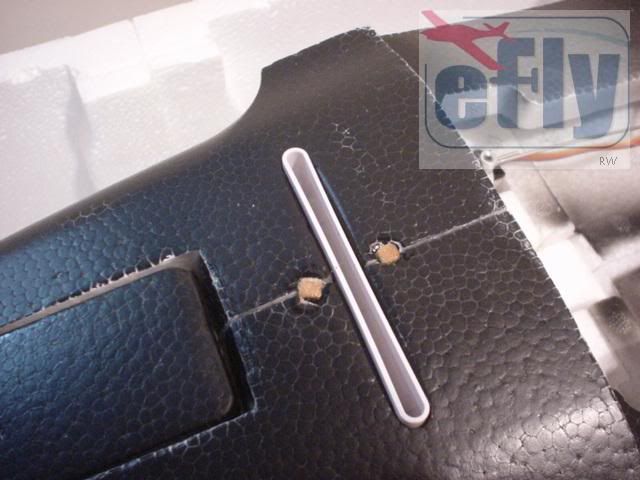
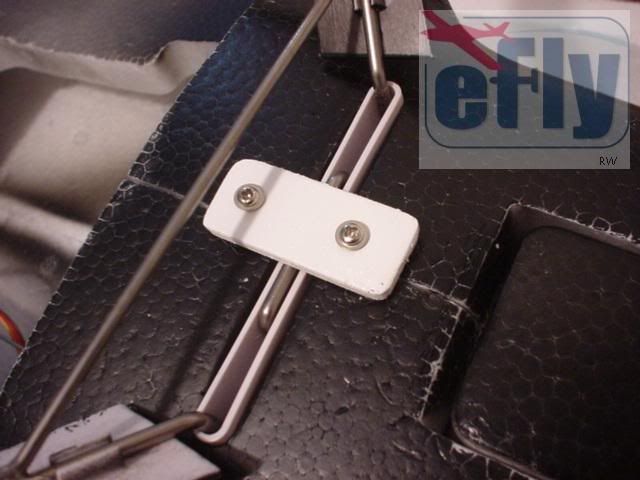
Spinner:
The spinner and backplate are made of a kind of brittle plastic. That makes installing the propeller very awkward as you have to be very careful not to brake the backplate while fastening the propnut.
(It promptly dissintegrated when I tried to remove the broken prop)
Battery hatch:
There is a battery hatch in the fuse's underside, right behind the wing and it is held in place by a magnet. You need to have real small fingers to be able to fit your fingers in the openings to open the hatch. I glued a piece of ribbon to the inside of the hatch sticking out, so I can hold on to something to open the hatch and reach the battery.

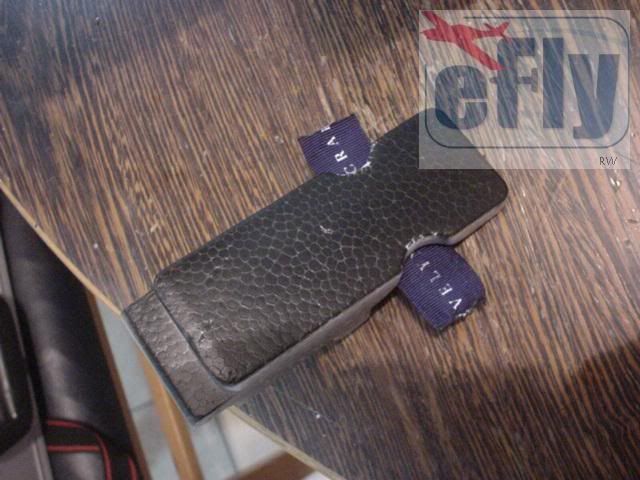
Radio installation:
There are several cavities inside the fuse where you can fit the Rx. There are no accommodations though for an "old fashioned" long 72mHz antenna. I glued a short piece of outer pushrod tube to the fuse's bottom, to lead the antenna unhindered to the rear.
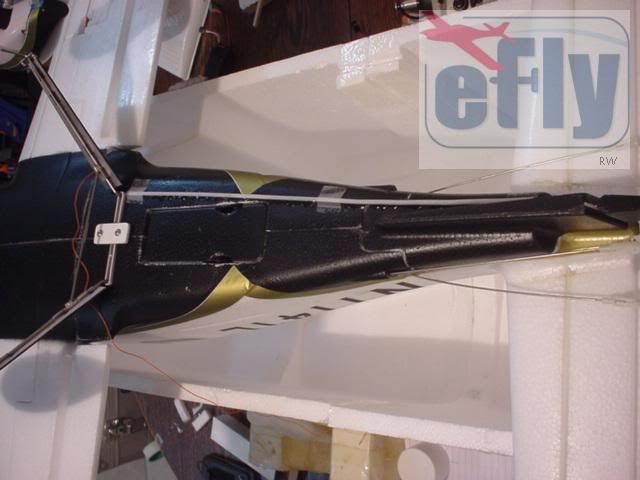
Cooling:
The motor and ESC are inside the cowl with plenty of cooling air circulating. The battery however is inside the fuse and there is absolutely no air circulating there. Do NOT overtax your lipos, or you could be seeing pretty puffs of smoke coming out of them.
The use of a Watt/Amp meter is an absolute must.
Cockpit:
There is a nice "office" with an instrument panel and seatbacks, but nobody home. To put a pilot (and maybe passengers) inside will involve major surgery, as the entire top is closed.
Cowl:
The fuse is white and black, and the cowl…light grey and black! This looks just wrong. How hard can it be to include a white and black cowl?

White fuse, grey cowl
Surface throws:
There is nowhere any indication on initial aileron. rudder or elevator throws. All EZ-connectors are on the inner most hole of the servo arm, thereby mechanically limiting the movement of the surfaces.
Flaps:
Included are the pushrods etc to activate the flaps. All you need to do is cut out the outsides of the flaps. Life hinges are already in place. That's the realy nice & good part. But the flaps are top hinged, thereby limiting the possible throw to about 45* down, at the most! Flaps on models usually are bottom hinged so you can get the full 90* throw.

Wing bottom. You can clearly see the top hinged flaps, and preparations to make the flaps operational.
MAIDEN FLIGHT
The previous evening I did some measuring. AUW, including the 3S 2200 Lipo, came to 1.406Kg and hooked up to my Wattmeter I read 22A and 230Watts. This should give enough power for flight, but probably not enough for high speed antics.
Early Friday morning (07h00) I unloaded the model from my car, attached the wing servos to the Rx and then the wing to the fuse. I inserted the battery in the most forward position, and checked the CG again (8cm behind the LE, as per the data on the instructions sheet).
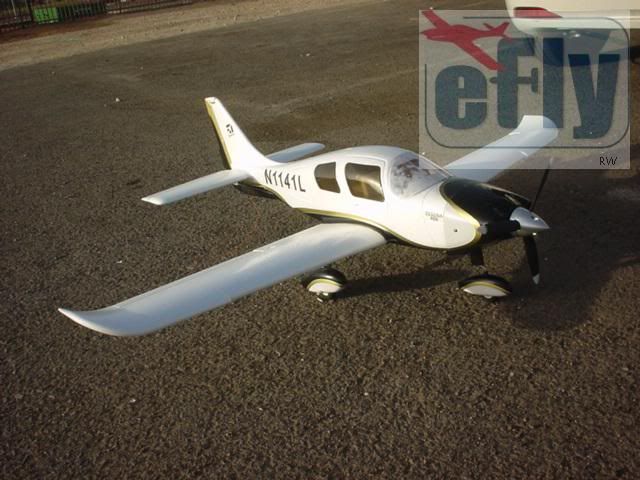
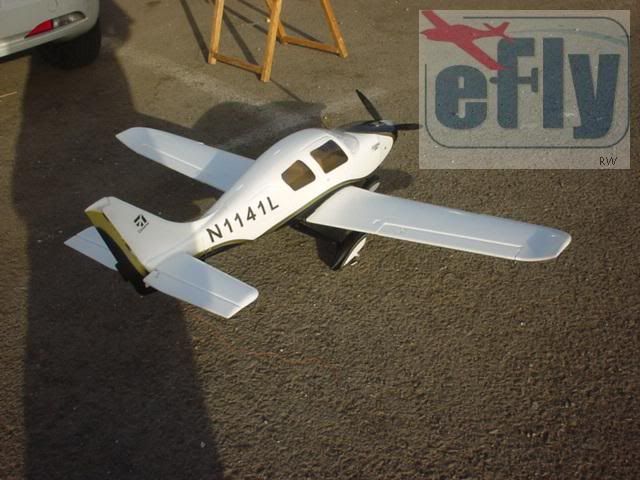
After a thorough range check with my new Corona synthesized Rx I did some taxi runs, to get a feel of the throttle and nose wheel response. That went fine, so I lined her up on the centerline and advanced to full throttle. After about 25 meters air appeared under the wheels. I tried to keep level to build up some more speed before climbing. The reason I didn't was because I had a distinct pitch problem. By then aborting was out of the question, as she was near the end of the runway, closing in on a fence.
I pulled up and gained altitude, while the pitch problem continued. It was a fight all the way up. While trying to trim her out, I realized the problem was almost for sure the model being tail heavy. In addition, there also seemed to be a distinct lack of power. There was no discernable difference between half throttle and full throttle. I am not entirely sure if this is due to the 3 bladed prop, or just a plainly under powered motor/ESC combo.
After flying one circuit I realized I should land to sort out the CG. Turning into final I didn't dare slowing down for fear of (tip)stalling. So fighting her down to the runway, the landing was hard. Most of the force was absorbed by the main gear, which sprung admirably. But the three blade prop hit the ground and the tips were shaved of, rendering it useless for further flights
So when I came home, I replaced the three blade 11x7 for a 2 blade 12x6, and cut out some foam to enable the battery to move further forward. I have room to move the battery at least another 2" forward, but will start with 1/4" increments.
Connected to my Wattmeter I got 27A and 315 Watts, static. That should show an improvement in the power department, and still within the parameters of the power combo.
Two more test hops further. The power is marginally better. The take of run is stil 20-25 meters, but she feels decidedly more "peppy". With the battery 2" further forward she also feels more solid. However, pitch still is very eratic, untill slowing down on final. That lets me to believe the 1mm pushrods for the elevators are not holding there own.
Back home I replaced the elevator pushrods with 1.5mm carbonfiber ones.
Another test hop. Still very pitch sensitive! On landing (a soft one, eye wittnesses will bear me out... ) the landing gear departed the fuse. Result; a whittled down prop, and...that was all. It seems the wood dowels were not enough to keep the LG in. So at home I replaced the wooden dowels with 10mm square blocks of hard wood.
) the landing gear departed the fuse. Result; a whittled down prop, and...that was all. It seems the wood dowels were not enough to keep the LG in. So at home I replaced the wooden dowels with 10mm square blocks of hard wood.
I also made arrangements to be able to push the battery even further forward.

Carved out some more foam from under the LG, and CA'd some foam blocks in place, to create a pocket for the battery.
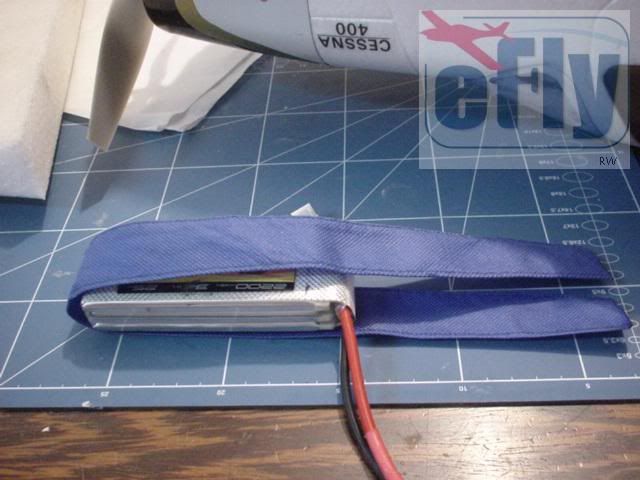
I found a ribbon (don't ask) to wrap around the battery, so I can pull it out of the pocket under the wing.
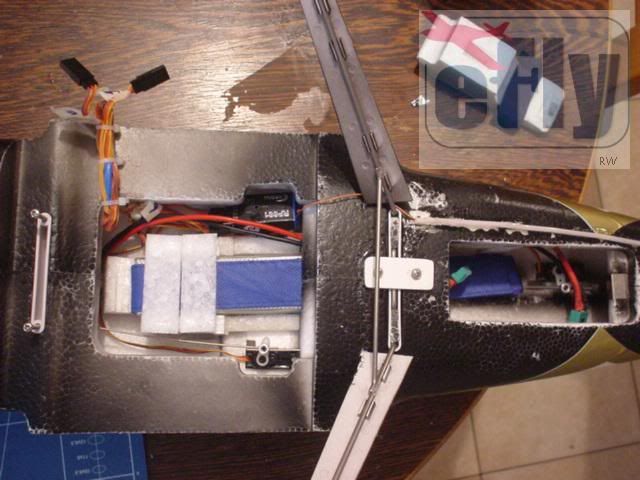
A view from the bottom... Battery under the wing, and ribbon sticking out into the original battery bay.
I'm also looking for another 12x6 E prop...
Ve VILL make yoo fly Mmmmuuhahahahahaaaaaahahahahahaaaaaa!
Another test flight.
Couldn't find another 12x6 prop, so I cut down a 13x10 prop to 12x10 (yes, yes, I balanced it as well...)
Early this morning I drove to Ashquelon to meet a friend, to make a video.
Still obviously tail heavy, but much better flyable. Did some low passes (not slow), and a loop and roll. It can be done on the standard power setup!
Landing was proper a kangaroo imitation. Entirely my fault, as I tried to land slowly for the camera, but got into trouble due to the tail heavyness.
At first glance no damage whatsoever.
My entrepid camera man than informed me that, oops, something had gone wrong and the entire flight was not recorded!
No problem (we thought), we'll do another flight. On take off roll the nose wheel got askewed and I entered the brush. One elevator half got torn of. I then noticed that the nosewheel pushrod had full flop, ie the nose wheel couold turn any way without the servo movement. That's what caused the crash.
Today's conclusion:
The battery must go further forward by at least another inch or two. Repairing the elevator will be no big deal, just CA in some CA hinges (if already, I'll do both sides).
Fix the nosewheel pushrod slop by glueing in a pushrod sleeve.
(video clip still to follow...)
Soooooo, the battery is now moved all the way to the front of the fuse, and I epoxied 110 grams of lead into the front of the cowl. CG is now on 40mm.
NOTHING was going to ruin my next flying day!
This morning my son agreed to come with me and video the event...
At the field all checks were go, including all servo movements. I pick up the Cessna and place her on the centerline of the runway, take two steps back, check the wind direction, one more wiggle of the sticks....and the elevator servo goes grrr grrr grrr grrrr....!
Yup, servo gear gone. No idea how, as all was fine 30 seconds before.
I am roally pissed of now.
But:
Ve still VILL make yoo fly Mmmmuuhahahahahaaaaaahahahahahaaaaaa!
Link to all pictures in Photobucket.com: http://s1235.photobucket.com/albums/...age/Cessna400/
נערך לאחרונה על ידי Up&Away; 26-11-2010 בשעה 10:37:44.
רנה
I don't make stupid mistakes. Only very, very clever ones...
) the landing gear departed the fuse. Result; a whittled down prop, and...that was all. It seems the wood dowels were not enough to keep the LG in. So at home I replaced the wooden dowels with 10mm square blocks of hard wood.